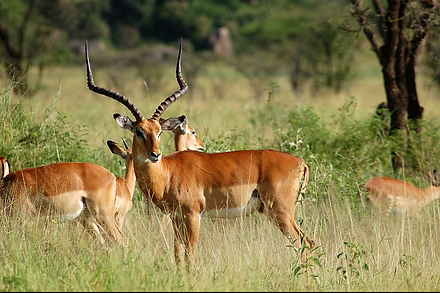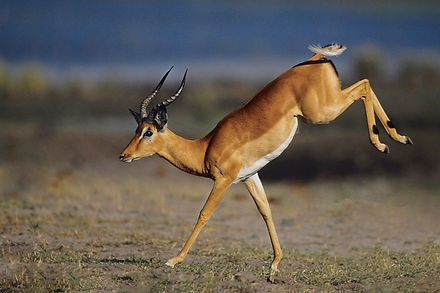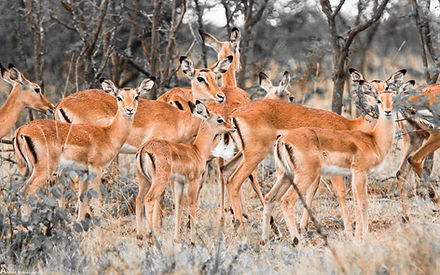Impala
Aepyceros melampus
General Description
Scientific Name: Antidorcas marsupialis
Subspecies: 2 subspecies
-
A. m. melampus (Common Impala)
-
A. m. petersi (Black-faced Impala)
Status: Least Concern (stable) for common impala, & Vulnerable (increasing) for black faced Impala.
Overall Total Population: 2,000,000+ Individuals
Population in Protected Areas: 1,675 Individuals
Description: Males weigh between 53-76 kg’s, and females between 40-53 kgs, with both sexes standing between 70-92 cm at the shoulder. Only males have horns, Lyre shaped and between 45-92 cm long. Sometimes females grow horns, but very rarely. The horns arch like structure allows competing males to interlock there horns, and throw each other off balance without causing significant damage to each other.
The impalas coat has two colour tones, being reddish brown across the back and shoulders, and white on the flanks with black lines running from the buttocks to the upper hindlegs. The face of the Nominate subspecies, the Common Impala (A. m. melampus) is mostly reddish brown in colour as well, apart from white rings around the eyes and snout. For the Black Faced subspecies (A. m. petersi), it has a dark stripe on either side of the nose, that runs upward to the eyes and thins as it reaches the forehead. It's also distinguishable by it's slightly larger size, larger black tip on it's ear, and a tail that's around 30% longer and bushier.


Ecology: Impala are a highly adaptable species, with the ability to both browse and graze, as well as snacking on fruits, seeds and nuts, depending on the availability of resources. They are however tied to the availability of a stable water source, especially in drier areas where water derived from plants is scarce. Studies have shown that on average, their diet consists of 45% Dicots, 45% monocots, and 10% fruits, with grasses becoming the primary food sources shortly after the first rains.
Impala habitat is also influenced by the species it shares the area with. For instance, in areas where elephants herds have reduced the density of bush and woodland, the amount of available forage for impala herds increases, especially during the dry season. Herds will also move between different types of habitat throughout the year, in order to access the maximum available nutrients.
Impala are considered an important prey base for many different apex predators in Southern Africa, including Lions, Leopards, Cheetahs, Spotted Hyenas, Painted Dogs, and large Nile Crocodiles. Young and infirm individuals will also be taken by a range of animals, including jackals, caracals, baboons, pythons, and large eagles.

Diet: Herbivore - Browser & Grazer
Male Weight: 53-76 kg
Female Weight: 40-53 kg
Trophy Size: 52 inches
Generation Length: 5.7 years
Reproductive Season: May
Time of activity: Diurnal/crepuscular
Behavior: For most of the year, Impala are separated between bachelor herds (made of young, subordinate males), female led herds, and territorial males. The mature territorial males join the female herds during the breeding season maintain harems of does. Female herds are usually the largest, ranging between 10-180 animals per herd, though larger groups of 200+ animals have been seen in productive areas during the dry season.
Because Impala are a common prey animal for many large predators, they are constantly on alert, and have developed several different strategies, including two incredible leaping abilities. The first type is usually a leaping jump, where they can cover close to 10M in a single bound, and jump 3M into the air. The second type is almost a pronk, involving a series of jumps where it lands on its forelegs, moves its hindlegs mid-air in a kicking fashion, lands on all fours (stotting) and then rebounds. Different fleeing strategies are used on different predators, depending on their hunting strategy. When alerted to danger, they'll let out a booming bark, delivered through one to three loud snorts with the mouth closed, followed by two to ten deep grunts with the mouth open and the chin and tail raised. Often these calls will alert other individuals (and other grazing species) to danger up to 2 km away.
Reproduction: the Impala breeding season usually kicks off at the beginning of the wet season (usually in early may) and last for three weeks, where dominant males gather females in harems, and try to mate with as many as possible. Though males reach sexual maturity after just a year, most won't have a chance to breed until their 4th or 5th year. Females will cycle into Oestrus for between 24-48 hours, in which a male will mate with her once, and then proceed to loose interest.
A Impala ewe's pregnancy last for around 7 months, after which she'll produce a single calf. During the first 3-4 weeks of it's life, the calf is vulnerable to predation from a whole range of predators, hence the ewe will proceed to hide the calf in tall grass or thick scrub away from the main herd, until it is able to run at high speed. At this stage, the calf joins a nursery group within the main herd, where it'll stay dependent on it's mother for the next 6-8 months.

.jpeg)
Conservation Analysis
Current & Historic range: Common Impala currently occupy much of their historic range, though are extirpated from Burundi. In many areas it has been introduced outside of it's historical range, into parts of Southern Africa, and into Gabon.
The natural range of the Common impala stretches from central and southern Kenya and northeastern Uganda in the east, down to KwaZulu Natal in the south, and to Namibia and southern Angola in the West. The Range of the Black Faced Impala was naturally restricted to Southwest Angola and Northwestern Namibia (specifically the Kaokoland region), though they've been widely transplanted by game ranchers across parts of Namibia and South Africa. Populations outside of their natural range are largely unmonitored.
Current & Historic Populations: Historical estimates of Impala populations are largely unknown, thought it is highly likely that they were significantly higher in recent history. Over some areas of their natural range, in particular South Africa, populations are stable or on the rise, where as in other places, in particular east African nations such as Kenya, Tanzania, Uganda and beyond, populations seem to be falling. Their populations inside protected areas and hunting reserves are stable and often increasing form historic overexploitation, but outside of these areas, population numbers are largely undocumented.
Most recent population estimates of the common Impala state that there are around 2,000,000 but the accuracy of this number is largely unknown. Population estimates conducted back in 2016 place the Black Faced Subspecies at approximately 3,000-4,000 individuals. This is almost definitely a outdated estimate, due to the lack of monitoring inside it's natural range, particularly in Angola, and also because of the undocumented animals on Game ranches outside of their historical range. Inside protected areas with ample habitat, population densities can be extremely high, such as in Mkomazi National Park in Tanzania, with densities of 135 animals per square km.
Threats to Species Survival: As a species, Impala are not in any immediate risk of extinction from any of the countries they currently occupy. A significant portion of their populations reside on protected reserves, and their adaptability allows the to thrive on human altered landscapes better than some other species. That being said, many populations outside of their protected areas tend to be fragmented, due to widespread poaching, habitat fragmentation, competition with livestock, and occasional disease outbreaks.
Due to the Impala's territorial nature, they can be heavily impacted by non-selective poaching with snares, dogs, and traps. Whilst other species might flee the area due to the unnatural hunting pressure, Impala tend to stick to one spot incessantly, until most of the population has been wiped out. They're also particularly vulnerable to poaching in the dry season (when a lack of water concentrates them around watering holes) and the beginning of the wet season, when young calves at foot make for easy targets for poachers with dog packs.
Conservation and translocations of the Black Face Impala outside of it's historical range has largely been a success story, greatly increasing the amount of available habitat, and leading to a increasing population trend. Game Farming of Impala has also lead to a significant rise in local populations in many parts of South Africa, due to their popularity and value as a game species.
Recommended Conservation Actions:
-
Continued range and population expansion using game farming and private reserves as habitat. Increasing herd sizes will increase it’s ability to reproduce successfully.
-
Further expansion onto small holding private property, such as cattle farms, where the blesbok are used as another source of revenue and sustenance for local peoples.
-
Increased monitoring capabilities across the Impalas current range, to better monitor wider population trends impacting the species.
Economic & Cultral Analysis
Ecotourism Value: Moderate-High
Hunting Value: High
Meat Value: High
Trophy value per animal: $300-1,000 USD
Meat Yield per animal: 15-28 kg
Economic Value/Impacts: Impala are now one of the most hunted game animals’ species in South Africa, and make up the bulk of the meat sold into the commercial markets for domestic sale, particularly for biltong production. Their small size, along with their propensity to browse for the majority of their diet, they tend not to compete with cattle very much (though they do compete with goats). Their ability to coexist with livestock has meant that many populations been maintained across large areas of private land, similar in many ways to Whitetail deer in the US. Compared to other species, their trophy value isn't particularly high, but due to the high densities ad quick growth rate, thousands are harvested of private lands each year, presenting a considerable value to landowners.
They are also somewhat valuable to the ecotourism industry, since they are such a commonly sighted animal, and a key prey species for lions, leopards and cheetahs, all species that are major drawcards for tourists.
Cultural Value: Impala have long been hunted by the native peoples of the entire continent of Africa, as well as the European colonizers that first arrived in the 15th century. Their meat, which is lean, rich in flavor, and highly nutritious, was sought out by early colonists, as well as their horns, which are large and rather beautiful for an animal of their size.
![Faunus_1.0-_(no_background)[1].png](https://static.wixstatic.com/media/684ede_9119f109be044e24997ff22fdfd55e34~mv2.png/v1/crop/x_31,y_0,w_365,h_402/fill/w_87,h_96,al_c,q_85,usm_0.66_1.00_0.01,enc_avif,quality_auto/Faunus_1_0-_(no_background)%5B1%5D.png)


